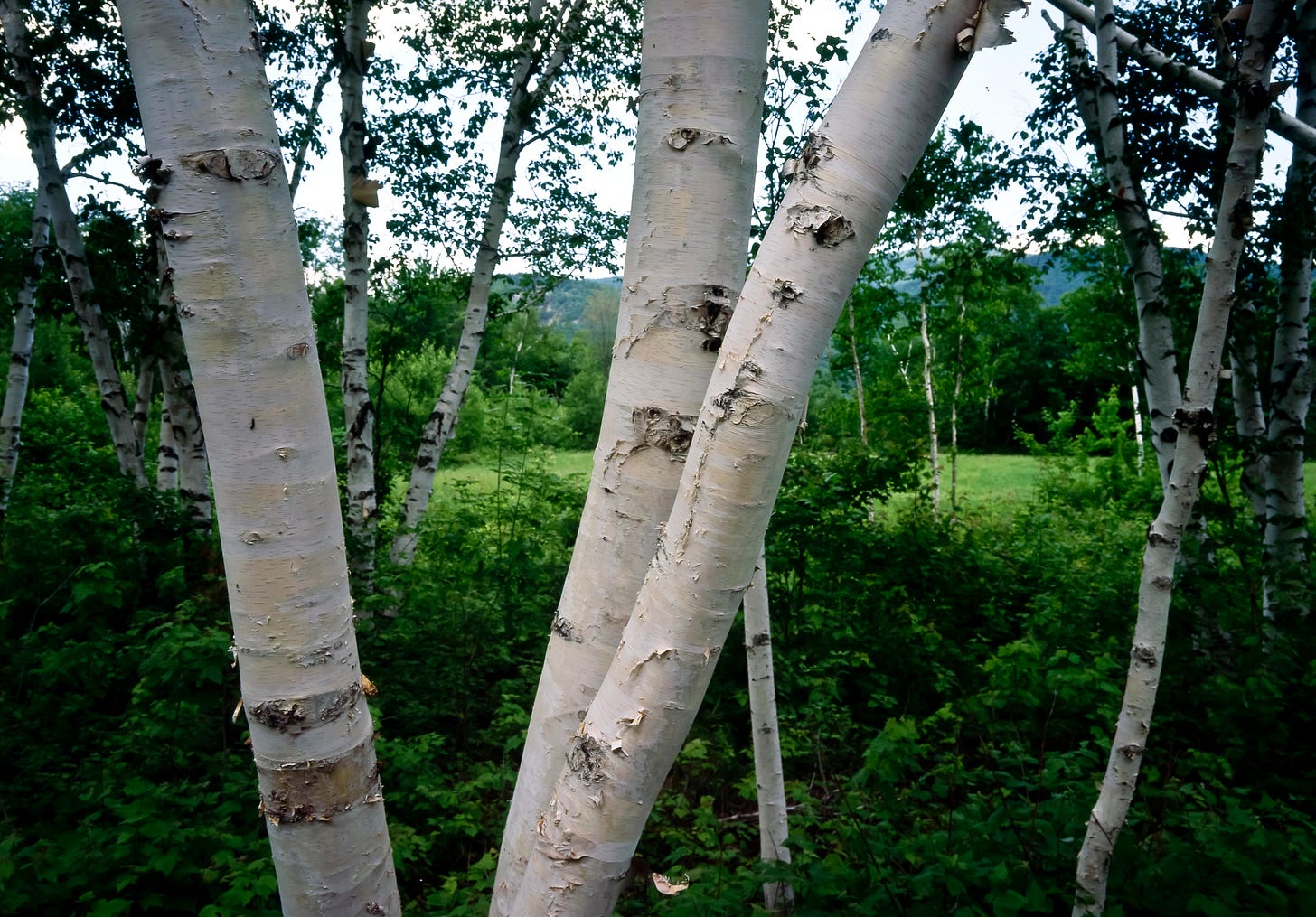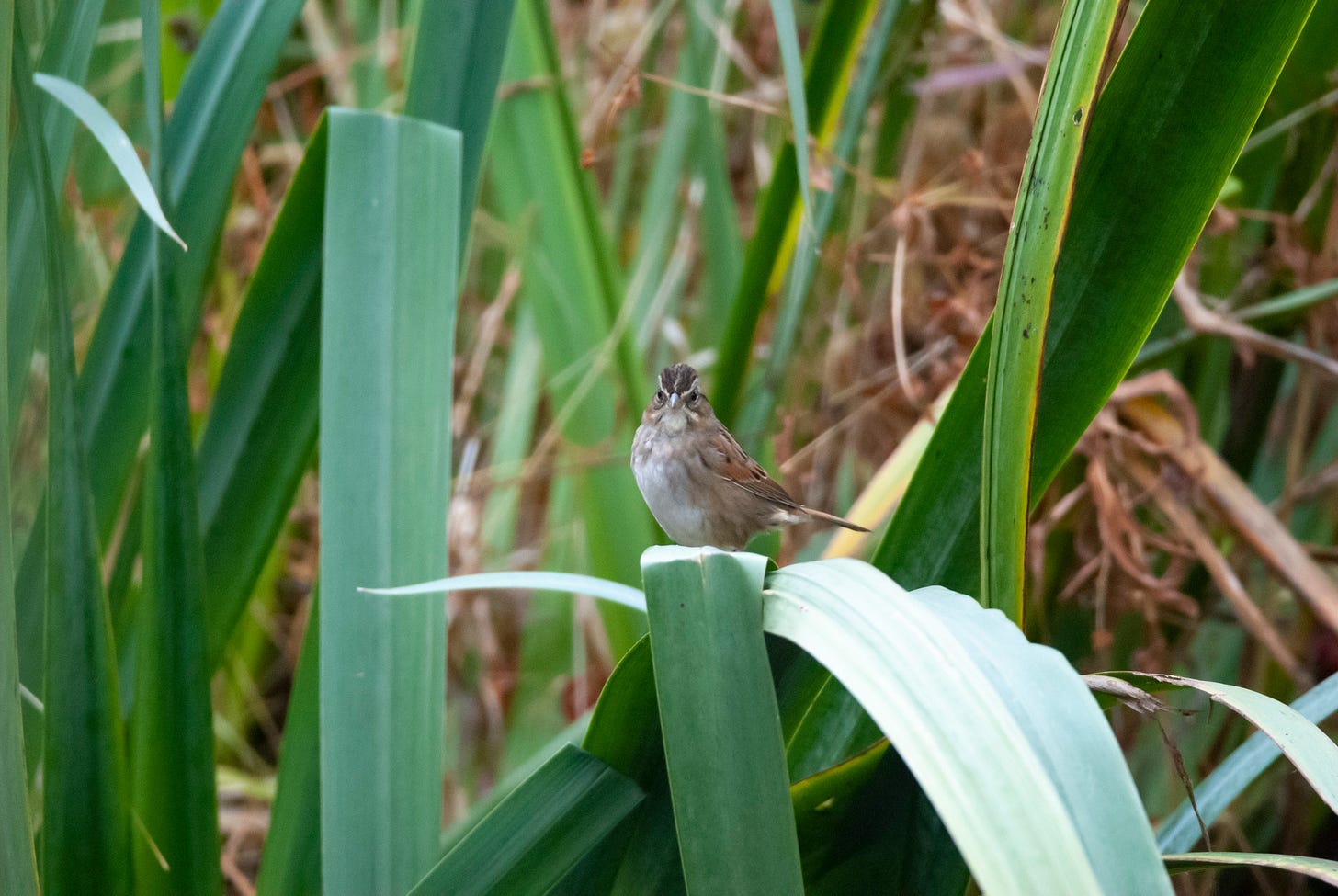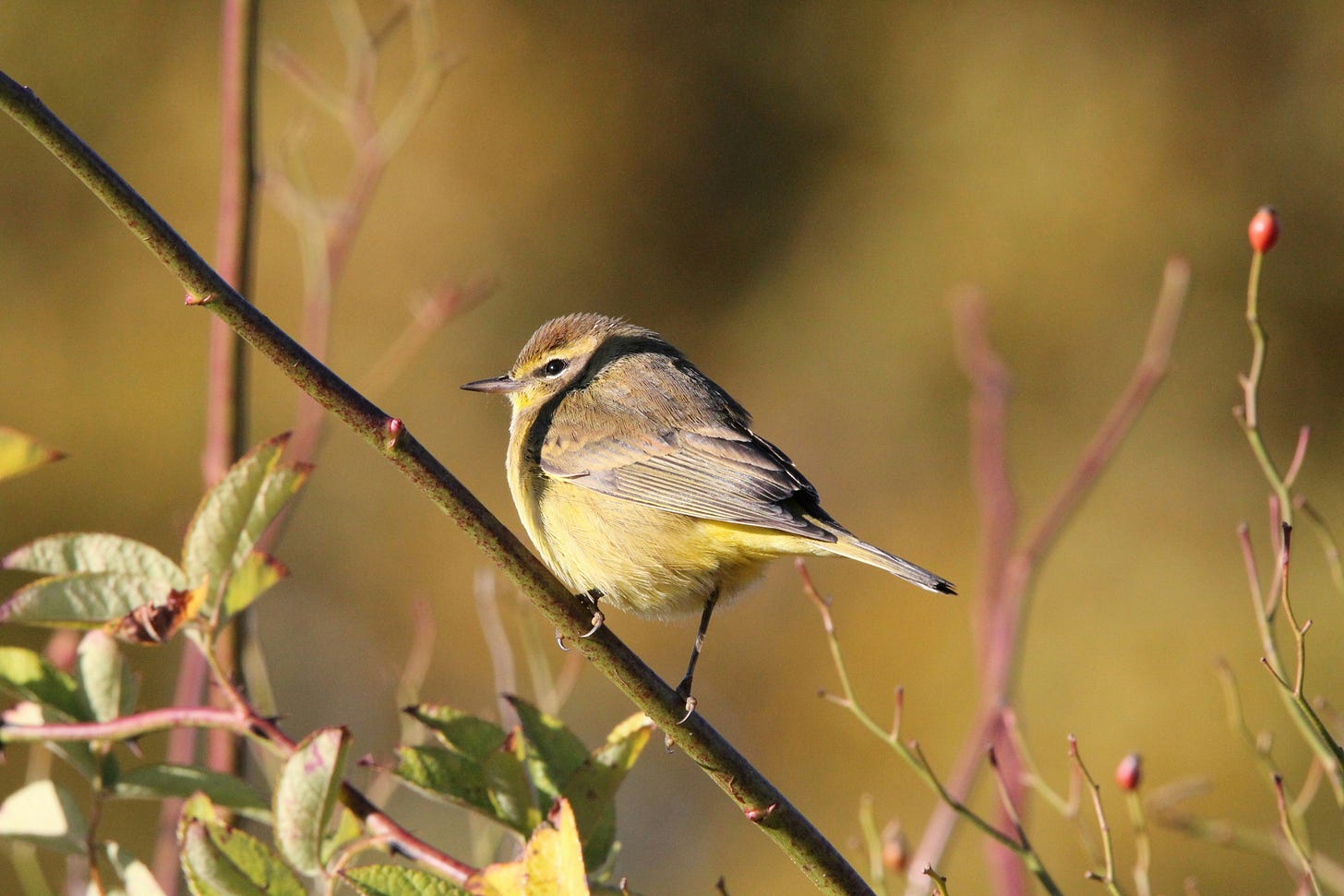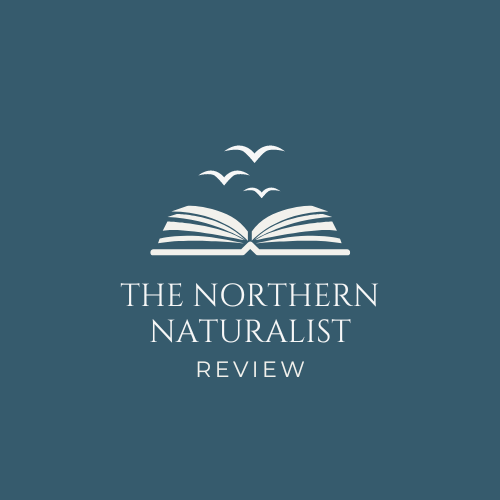You say Trembling, I say Quaking: Northern Naturalist #22
Aspen, Learn the Trilling Birdsongs, Review of The Round of a Country Year, by David Kline, plus News and Notes
Quaking Aspen (Populus tremuloides) is a major tree of the North Woods. It grows across the continent from the northern tier of United States almost up to the tree line. It is the most widely distributed tree in North America. It is a tall, fast-growing tree. Its leaves are round, with small, rounded teeth. The leaves are green above and grayish-green below. The bark is whitish and feels chalky to the touch. It is marked with thick, dark scars and knots.
Aspens are shade-intolerant, so as shade-tolerant conifers grow up between them, they serve as nurse trees, protecting the young conifers from wind and ice and allowing snow to pile up around them, protecting them from cold. Once the conifers out-grow the aspens, however, the aspens will die in the shade. They are early colonizers, so when an area has been cleared by fire, wind, or logging, they will be among the first to begin to grow. They are dominant in parts of our landscape now in a response to the extensive logging of the late nineteenth and early twentieth centuries.
More than once, I have had the experience of birding with someone who pointed out a bird in the “birches”. Sure enough, the bird was in a white-trunked grove, but the trees were not birches—they were aspens. At even a short distance, these trees can be a little confusing. They may both have white trunks, although sometimes aspen trunks may be greener or grayer.
The key is to look for any kind of tearing or peeling. If it is peeled at all, it’s birch. If the bark is entirely smooth, then it’s aspen. Up close, there are other differences, but, at a distance, it may be hard to see these other field marks.
In common with conifers, aspens bloom early and count on the winds for pollination. Aspen reproduction is frequently unsuccessful, because the tree blooms early in the year when the weather may not be conducive to germination (it has very particular requirements for germination). The seeds are only viable for a few weeks (this is quite unusual—the seeds of many plants remain viable for years). In addition, the trees of a clone will be of one sex, so in a large clone, pollination of most of the clone will be unlikely.
However, aspens can also “reproduce” through their root systems, which spread and sprout new stems (trunks). This isn’t true reproduction; the new trees have precisely the same genetic makeup as the originating tree. Most of the aspen trees you see in the woods will have grown this way. Groups of trees that have grown up this way are called clones, and they are often enormous and very old—some of the largest and oldest organisms on earth. Looking at an aspen-laden landscape in the distance, you can distinguish clones in the spring and fall, because each tree in a clone will bud, grow leaves, turn color, and drop leaves at the same time. When these events are happening, you can see the boundaries between clones. In the photo below, you can see a couple of clone boundaries to the right.
I always think of them as Quaking Aspen, but some call them Trembling Aspen. The reason for both names is that each leaf has a flat petiole (stem) that is perpendicular to the plane of the leaf. In the slightest breeze from any direction, the leaves will wobble—or quake, or tremble, as you wish.
Learn the Songs of Trilling Birds
The next group of birds that may help you sort out who’s who in the welter of spring and summer bird song is those that trill. By “trill,” I mean a fluttering or tremulous song (not to say Quaking or Trembling). The category isn’t airtight, because there are other bird songs that sort of fit, but I am excluding them due to the overall impression they give being dominated by some other quality (like buzzing, or rising, etc.) The descriptions here apply only to the spring, territorial song. (I have provided links to recordings on xeno-canto.org. Keep in mind as you listen that the recordings are of just one, single bird. I actually think these species are easier to distinguish live than it seems when I listen to the recordings. If the recordings don’t help, ignore them and get out and find some real singers!) These birds may make many other sounds. The first three species give ample opportunities to be heard, and they are easier to distinguish; as always, the best teacher will be experience. I’m hoping this will get you started.
Chipping Sparrow
The most common triller for most people will be Chipping Sparrow (Spizzella passerina). They nest in many upland habitats, and they are also common city-dwellers. Their trill is a long, flat, dry, machine-like song. (The song of Worm-eating Warbler is close, but a little less staccato and swells in volume; they breed in the southeastern United States, so they are rare here, but there are occasional records.)
Swamp Sparrow
Swamp Sparrow (Melospiza georgiana) is widespread over the eastern two-thirds of North America, but it is missed by many, due to its strong preference for wetlands, especially cattail marshes. It is one of the unusual birds that is aptly named. It’s trill is loud, clear, and slower than the others here.
Pine Warbler
Pine Warbler (Setophaga pinus) lives in the eastern half of the United States, its range barely reaching into Canada and the Caribbean. Like the Swamp Sparrow, it has a strong habitat preference, and for this species, it’s pine trees. They love mostly solid stands of various species of pine, but they will nest in mixed stands, so long as pine is a strong component of the mix. Their trill is the most “musical” of this group: a simple, rapid, evenly-spaced trill. Unlike the others here, it sounds sweet to my ear. They will alternate slow and fast versions of the trill—another clue.
Dark-eyed Junco
The trill of the Dark-eyed Junco (Junco hyemalis) has a ringing quality to it. I don’t hear the trill more than a few times a year, because I mostly experience this species in migration, when it’s not usually singing. It has some music to it, but is not as consistent as a Pine Warbler.
Palm Warbler
Palm Warbler (Setophaga palmarum) ranges across the eastern two-thirds of North America and well north into Canada. Their trill is a thin, dry, weak trill. This is another bird that will mostly be seen in migration; their breeding territories in bogs are usually remote from humans. Probably toughest to distinguish from junco.
Review of The Round of a Country Year: a Farmer’s Daybook, by David Kline (Counterpoint, 2017)
David Kline is an Amish farmer and naturalist who lives in Ohio. The Round of a Country Year takes the reader through the year in diary-like fashion. There’s a mix of description of his farming activities, natural history, and community activities. Kline is an Amish bishop, and he describes what that means a little, but it’s not a major focus of the book.
Even though Kline provides an introduction to the “cast” of his book, there is a bit of the experience of reading a Russian novel, in that there are so many characters that it’s hard to remember who’s who. This doesn’t diminish the enjoyment of the book, and it’s quite a testament to the amazing interconnection of the farm families in Kline’s community.
He describes his daily activities as a farmer at various points of the year. He obviously loves natural history. Given how busy he is, I don’t think he gets many chances to just go birding, but since he lives in the country, he catches a lot.
There are many interesting tidbits in the book, such as his telling that his colony of Purple Martins chased the kestrels away; following the demise of the martings for some reason, kestrels would come and feast on the colony of cliff swallows on his barn.
There are some tantalizing descriptions of food, and there is a lot of work! Kline quotes Dwight Eisenhower, who said, “Farming looks mighty easy when your plow is a pencil and you’re a thousand miles from the cornfield.” (p. 38)
David Kline has written other books, including Great Possessions: An Amish Farmer’s Journal, 1991 and Scratching the Woodchuck: Nature on an Amish Farm, 1997. Both are similar descriptions of the intertwined natural and social history of his community, enhanced by his calm, conversational tone and fine writing. It’s been a while since I read these, but my recollection is that Scratching the Woodchuck is more separate vignettes about specific animals and plants, while Great Possessions is more similar to The Round of a County Year in its diary-like recounting of the seasons.
Both Great Possessions and The Round of a Country Year have interesting prefaces by Wendell Berry, who is also a farmer and great writer. I found reading The Round of a Country Year to be a pleasant escape during a busy and stressful time.
News and Notes
Spring migration is booming! Birders are reporting first-of-year species everywhere. I am still really restricted in my birding time, but I have added a few new ones: Brown-headed Cowbird, Gray Catbird, Merlin, and Common Tern.
My friend, subscriber, and reviewee, John Pastor, followed up last issue’s piece on robin-like songs to let me know that it is often said Antonin Dvorak’s American String Quartet (#12 in F Major, Opus 96) includes an imitation of the song of the Scarlet Tanager, which Dvorak would have heard during the time he lived in Spillville, Iowa. Further, John found an article in the journal, Iowa Bird Life, that suggests that the quotation is not, in fact, a Scarlet Tanager, but a Red-eyed Vireo (Iowa Bird Life, Fall, 2016, Volume 86, Number 4, pp. 29-31.) It seems plausible, and it raises the question, “Did Dvorak misquote the Scarlet Tanager?” Or “Did Dvorak know it was a vireo, and some musicologist made the mistake?” The Covert Sax Quartet posted this recording of the section in question; the introduction to the video lays out their thoughts about it. Either way, a fair amount of imagination is required to hear a bird; and either way, it’s a lovely piece of music.
More than one poet has called May “the Queen of months.” Yet here in the North, May is often more like Cinderella, waiting for the fairy godmother of June or even the handsome prince of July. Things feel a lot like they did a few weeks ago, except the snow is gone and the weekend’s rain is putting a little green in the grass. By the end of the month, it may feel more springish, or cold may return again once or twice. Soon I’ll be stepping out into the dusk on a quiet May night, listening for one of my favorite sounds—the quiet crinkle of plants pushing up through the leafy duff.
Wishing you a spring-like spring—thank you for reading!

















Thanks again for brightening up my day with thoughts of aspen groves and trilling birdsong and a reminder of how fine a thing it is to be curious.
I love the bit on the "trilling" birds as we just returned from a trip to Itasca and Cass counties and all of these birds were present. I must confess the Merlin APP helped quite a bit as they can sound somewhat similar. My hat is off to all the birders who figured it out before all the techno help. Beautiful birds all the same and felt so lucky to catch them passing thru.